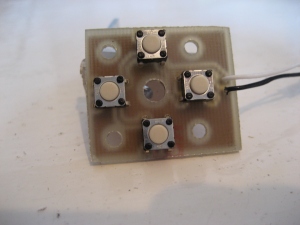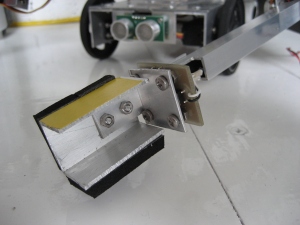Robot hand switches revisited
June 18, 2013 2 Comments
I have been thinking lately about a better design for the switches on my robots hands. The design posted on here previously simply used tactile switches mounted to the robots hands to sense when the hand came into contact with something. I always knew this had major limitations so a new design was needed. The biggest limitation was the small area of the switch, meaning it was a bit of luck whether the switch hit an object or another part of the robot hand did. What I really wanted was a hand design that would switch whenever the hand came into contact with an object, from any angle or direction. I also wanted the switch to trigger easily, so that the robot knows as soon as possible when its hand has hit something. I used these requirements to come up with a design that would do the job.
My new design still uses tactile switches, 4 per hand, on a custom made PCB. Have a look at the picture below to see the PCB.
This PCB mounts to a bracket that is attached to the end of the robot arm, perpendicular to the arm. A piece of expanded PVC sits between the bracket and the PCB. This provides electrical insulation and compresses slightly to keep the PCB firmly fitted to the bracket. The mounted PCB is shown in the picture below.
A second bracket mounts to the PCB but on the switch side. This bracket is held on with 4 bolts but is left slightly loose so it is free to move and press down on the switches. A U shaped section of aluminium completes the hand, attached to the second bracket. When the hand comes into contact with an object, the second bracket is pushed into the switches and triggers a signal to the Arduino. The picture below shows the final assembly, mounted to the robot.
I’m very pleased with this set-up. I have done some simple tests and it functions perfectly. No false triggering and it only takes a small force on the hand to trigger the switch. The assembly is sturdy and should last a long time. I also think it looks quite good, if I do say so myself!


